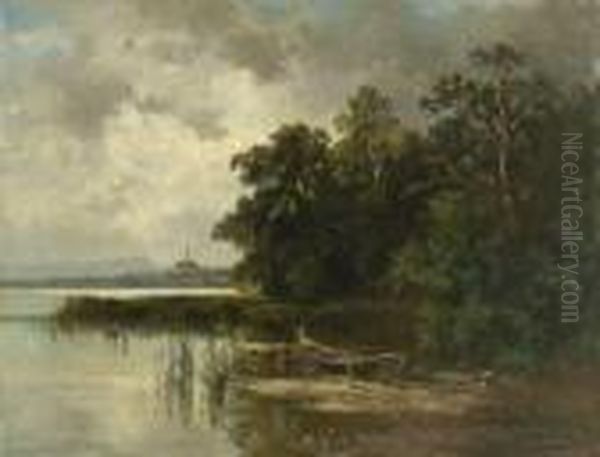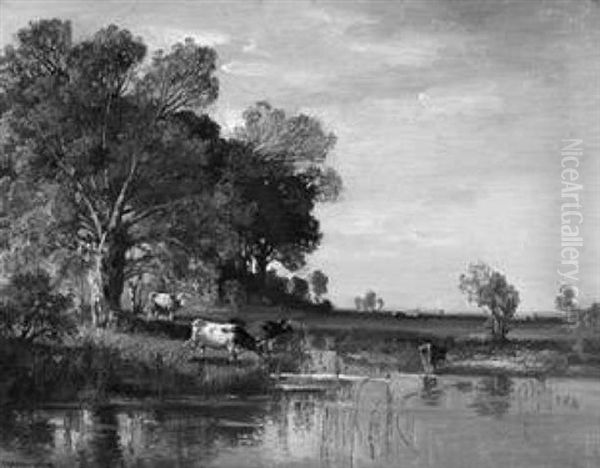Introduction to the Artist
Fritz Halberg-Krauss (1874–1951) stands as a significant figure in early 20th-century German art, particularly noted for his contributions to landscape painting. A German national, he dedicated his career to capturing the natural beauty of his homeland, working primarily in a Naturalistic style. His deep connection to the traditions of German art history places him as one of the last important representatives of the esteemed "Munich School," a movement renowned for its realistic and atmospheric depictions of the world. Halberg-Krauss's work focused intently on the nuances of the German landscape, especially its forests, wetlands, and rural scenes.
His paintings are celebrated for their meticulous attention to detail, a hallmark of Naturalism, combined with a profound sensitivity to the interplay of light and shadow. This ability to render atmospheric conditions and the textures of nature imbues his work with both high artistic merit and considerable historical significance. He captured moments in time within landscapes that were rapidly changing, preserving views of areas like the Freisinger Moos and the regions around the Main River for future generations. His legacy is tied to his mastery of traditional techniques and his dedication to the landscape genre during a period of burgeoning modernism.
Artistic Style and the Munich Tradition
Fritz Halberg-Krauss's artistic output is firmly rooted in Naturalism. His primary subjects were the diverse landscapes of Germany, with a particular fondness for the countryside of northern and southern Germany. He frequently depicted scenes featuring rivers, lakes, expansive fields, and quiet pastures. Oil paint was his preferred medium, allowing him to build up layers of colour and texture to achieve the verisimilitude he sought. His style is often described as a "fine Naturalism," indicating a high degree of detail and finish in his work, avoiding the looser brushwork that characterized Impressionism, which was developing concurrently across Europe.

He is critically recognized as a late torchbearer for the Munich School. This influential school of painting, flourishing primarily in the 19th century, emphasized realism and technical proficiency, often focusing on genre scenes, historical subjects, and, significantly, landscape painting. Artists associated with the Munich School, such as Eduard Schleich the Elder and Adolf Lier, had already established a strong tradition of landscape painting focused on capturing the specific moods and atmospheres of the Bavarian countryside. Halberg-Krauss continued this tradition, bringing his own distinct sensibility to familiar subjects like forests, moors, and grasslands.
The Essence of Naturalism in Halberg-Krauss's Work
Naturalism, as practiced by Halberg-Krauss, involved more than just accurate representation. It required a deep observation of the natural world – the way light filters through trees, the reflection of the sky on water, the specific colours of moss on damp ground, or the texture of soil in a field. His paintings aimed to convey an authentic sense of place and atmosphere. This approach distinguished itself from idealized Romantic landscapes or the subjective colour experiments of later movements. It was about finding the beauty and truth in the observable world.
His commitment to Naturalism is evident in works like Holzfäller im Freisinger Moos (Lumberjacks in the Freisinger Moor), painted in 1942. Sources note his use of green mossy tones to capture the unique beauty of this specific wetland landscape near Freising, Bavaria. This attention to local colour and specific environmental details is characteristic of his approach. He sought to immerse the viewer in the scene, providing a faithful visual record combined with an artist's sensitivity to composition and mood.
Subject Matter: Depicting the German Landscape
Halberg-Krauss demonstrated a particular affinity for specific German regions. His canvases often transport the viewer to the scenic areas of Southern Germany, including the Werdenfelser Land, the Chiemgau region with its famous lake, and the distinctive Dachauer Moos (Dachau Moor). These locations provided him with ample inspiration, offering diverse terrains from alpine foothills to expansive wetlands. The Freisinger Moos, another Bavarian moorland area, also featured prominently, as seen in the aforementioned Holzfäller painting.

Beyond Bavaria, his work also captured other German vistas. The painting Stadtprozelten am Main depicts a town along the Main River, showcasing his ability to integrate architectural elements within a natural setting. Lakes were another favourite subject, with works like Am Ufer des Ammersees (On the Shore of Lake Ammersee) and paintings of Lake Starnberg capturing the tranquil beauty of these large bodies of water. His focus remained consistently on the interplay between land, water, and sky, often featuring cattle or solitary figures to provide scale and context, as seen in titles like Kühe am Baum bestanden Ufer (Cows on the Tree-Lined Bank) and Kühe im Wasser (Cows in the Water).
Technical Skill and Stylistic Characteristics
Halberg-Krauss's technical proficiency in oil painting was considerable. His works generally exhibit a careful application of paint, resulting in detailed renderings that hold up to close inspection. While adhering to Naturalism, his paintings were not mere photographic reproductions. He employed artistic license in composition and emphasis to heighten the emotional impact or visual interest of a scene. A notable characteristic mentioned in the source material is his use of strong contrasts, both in terms of colour and composition.
This use of contrast likely involved juxtaposing light and shadow effectively to create depth and drama, or perhaps using complementary colours to make certain areas of the painting resonate. This feature is highlighted as giving his work a unique standing, even within the broader context of the Munich School. While many Munich painters excelled at atmospheric effects, Halberg-Krauss's "extreme" stylistic features, possibly referring to these contrasts or a particularly rigorous form of Naturalism, set his work apart. His ability to balance detailed observation with strong compositional choices was key to his success.
The Context of the Munich School
To fully appreciate Halberg-Krauss's position, understanding the Munich School is essential. Centred around the Munich Academy of Fine Arts, it was a dominant force in German art from the mid-19th century into the early 20th century. It attracted artists from across Germany and Europe, known for its emphasis on solid draftsmanship, realistic representation, and often a somewhat dark, tonal palette derived from Dutch Old Masters. Key figures associated with its various phases include the genre painter Carl Spitzweg, the highly successful portraitist Franz von Lenbach, and the history painter Wilhelm von Kaulbach.

In landscape, the school evolved from more Romantic beginnings towards greater realism and naturalism. Artists like Eduard Schleich the Elder and Josef Wenglein were pivotal in developing a style focused on capturing the specific light and atmosphere of the Bavarian highlands and moors. They often worked outdoors (en plein air) to capture immediate impressions, though finished works were typically completed in the studio. Halberg-Krauss entered the scene as this tradition was well-established, inheriting its techniques and thematic concerns but continuing to practice them well into the 20th century, a time when avant-garde movements like Expressionism were gaining prominence elsewhere in Germany (e.g., Die Brücke group with Ernst Ludwig Kirchner).
Relationships with Contemporaries
The available information suggests little about specific rivalries between Halberg-Krauss and his contemporaries. His focus seems to have been primarily on his personal artistic exploration of the landscape genre. Unlike figures in other periods or locations, such as the documented rivalries involving the Ming Dynasty painter Dai Jin, Halberg-Krauss's career appears less marked by public artistic disputes mentioned in critical literature. The art world of Munich during his active years was vibrant, featuring artists ranging from traditionalists to members of the Munich Secession (founded 1892), which included figures like Franz von Stuck, Lovis Corinth, and Max Slevogt, who were exploring Symbolism, Impressionism, and early Expressionism.
However, direct competition or collaboration with these figures is not specifically documented in the provided sources concerning Halberg-Krauss. His adherence to the established Munich School style might have placed him somewhat apart from the more radical innovators. Yet, he was not entirely isolated. A documented instance of collaboration or joint presentation occurred relatively recently in terms of historical recognition: an exhibition held from October 15 to November 27, 2022, at the Heimatmuseum in Prien, Germany, featured works by Fritz Halberg-Krauss alongside those of Gertrud Gruber. This indicates an ongoing interest in his work and its presentation alongside other artists.
Market Performance and Auction Records
Fritz Halberg-Krauss's works appear regularly on the art market, primarily at auctions in Germany and surrounding countries. His paintings generally achieve prices that reflect his status as a recognized, skilled representative of the Munich School, though perhaps not reaching the levels of the school's most famous 19th-century proponents or major Impressionist figures. Auction estimates provide a snapshot of his market valuation during the early 21st century.
Estimates mentioned in the source materials range from around €400 to €1200 for several works. For instance, Holzfäller im Freisinger Moos (1942) and Am Ufer des Ammersees (1917) were both estimated at €400. Works like Stadtprozelten am Main and Kühe am Baum bestanden Ufer carried estimates of €800 to €1000. A painting titled Im Dachauer Moos was estimated slightly higher at €1000 to €1200. Another piece, Kühe im Wasser, had an estimate of €400 to €600. A landscape painting offered in Poland, Pejzaż z urwiskiem i drzewem, had an estimate of 3000 to 6000 PLN. A painting depicting Lake Starnberg was noted with a higher estimate of €1500 to €2000.
These figures suggest a consistent but moderate market presence. The commentary notes that Halberg-Krauss is sometimes considered "underestimated" despite his genuine connection to the Munich School tradition and the inherent quality of his naturalistic paintings. This suggests that while collectors appreciate his work, it may offer potential value compared to more heavily promoted artists of the era. His inclusion in multiple auction catalogues confirms his established place within the market for German art of this period.
Legacy and Significance
Fritz Halberg-Krauss's primary legacy lies in his steadfast dedication to Naturalistic landscape painting within the Munich School tradition, extending its practice well into the mid-20th century. In an era marked by artistic revolutions and the rise of abstraction, he remained committed to the careful observation and representation of the natural world. His works serve as valuable documents of the German landscape, particularly the moors and lake regions of Bavaria, captured with technical skill and atmospheric sensitivity.
He stands as a bridge figure, connecting the strong 19th-century German landscape tradition, influenced by artists like Wilhelm Leibl in its commitment to realism, to the mid-20th century. While perhaps overshadowed during his later years and posthumously by the rise of modernism and the fame of German Expressionists like Emil Nolde or Impressionists like Max Liebermann, his work retains its appeal for its quiet beauty, technical assurance, and evocative portrayal of nature. The description of him as a "true representative" and one of the "last important representatives" of the Munich School underscores his role in maintaining and concluding a significant chapter in German art history. His paintings continue to be appreciated by collectors and institutions focused on German Realism and Naturalism.
Conclusion
Fritz Halberg-Krauss was a dedicated German painter whose life's work centered on the naturalistic depiction of his country's landscapes. Born in 1874 and passing in 1951, he operated within the respected tradition of the Munich School, becoming one of its final notable practitioners. His oil paintings, known for their fine detail, sensitive handling of light and atmosphere, and sometimes strong contrasts, captured the essence of German forests, moors, rivers, and lakes, particularly in Bavaria.
While specific anecdotes about his life or direct rivalries with contemporaries like Adolf Hölzel or other Munich Secession members are scarce in the provided records, his collaboration in exhibition with Gertrud Gruber shows his continued relevance. His works, including Holzfäller im Freisinger Moos and Stadtprozelten am Main, are testaments to his skill. Though sometimes considered underestimated in a market context compared to the giants of the Munich School like Franz von Lenbach or pioneers of modernism, Halberg-Krauss maintains a steady presence at auction. His contribution lies in his masterful continuation of the Naturalist landscape tradition, offering beautifully rendered views of Germany's natural heritage that remain appreciated for their artistic quality and historical value.